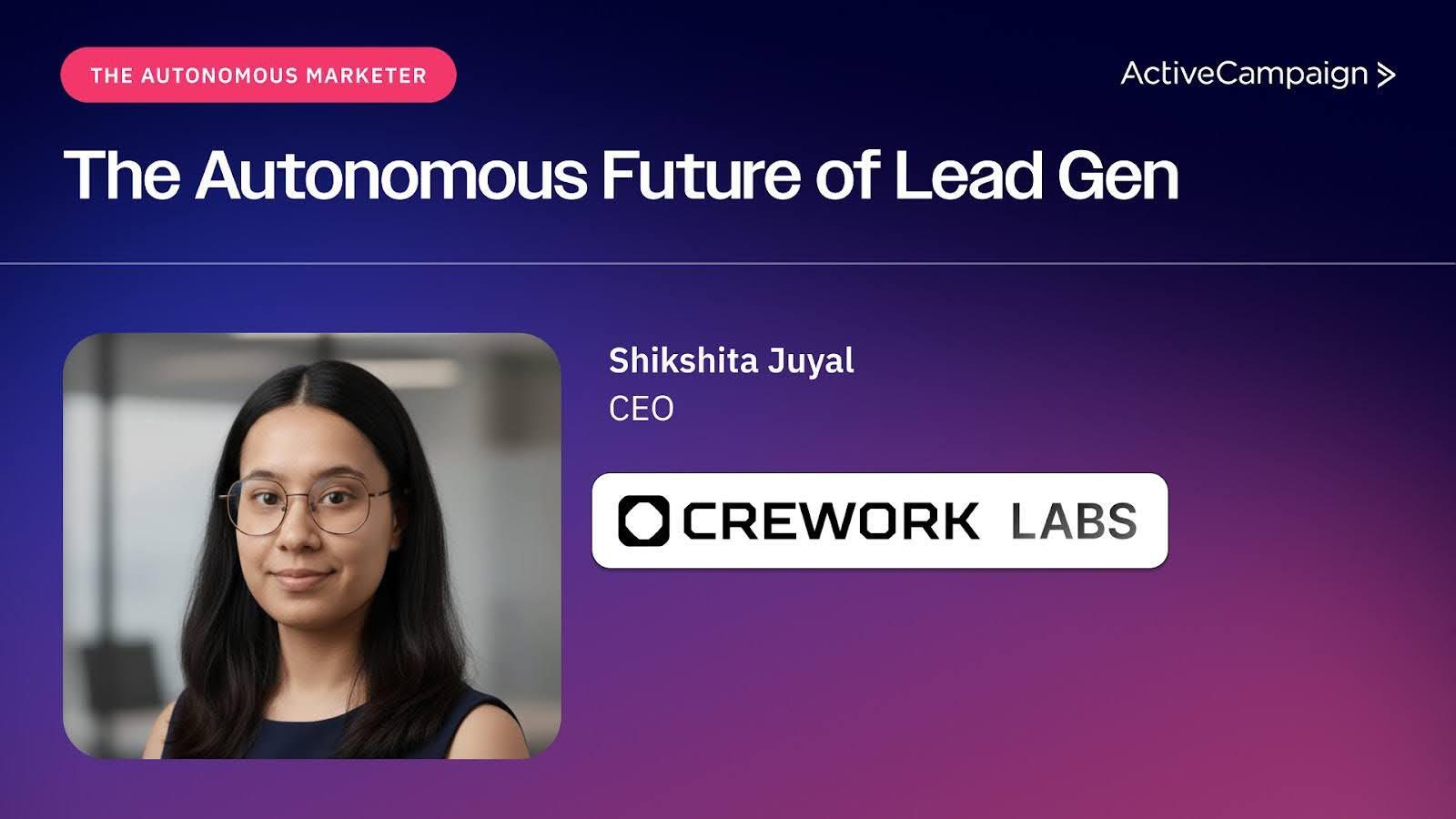From small digital storefronts to sprawling online marketplaces, e-commerce has undergone a remarkable transformation over the past couple of decades. The birth of the internet provided businesses with a new avenue to reach their audience, and over time, it has become a dominant force in the global market. Today, with the convenience of a click or a tap, consumers from every corner of the world can browse products, compare prices, and make purchases without ever stepping foot inside a physical store.
This immense growth of online shopping has made strategic e-commerce marketing an absolute necessity. In a vast digital landscape brimming with competition, simply having an online store isn't enough. Brands need to harness the power of e-commerce marketing strategies to stand out, drive sales, and foster customer loyalty. It's not just about selling products anymore; it's about crafting a unique user experience, understanding your ideal customer, and leveraging platforms like ActiveCampaign to engage with your audience effectively. As we delve deeper into the intricacies of e-commerce marketing, we'll explore how brands can optimize their marketing efforts and utilize platforms to their maximum potential in the digital age.
Overview of e‑commerce marketing
E-commerce marketing, a pivotal aspect of the modern digital landscape, offers brands an avenue to reach audiences beyond traditional borders. While physical stores have their charm and unique benefits, the world is steadily moving towards a digital-first approach to shopping. Through this section, we'll provide a comprehensive understanding of what e-commerce marketing entails and the myriad benefits it brings to brands and businesses.
Take a look at a list of e-commerce trends you can use to engage your customers.
What is e-commerce marketing?
E-commerce marketing is the practice of using promotional tactics to drive traffic to your online store, converting that traffic into paying customers and retaining those customers post-purchase. It encompasses a wide array of marketing activities, from the content displayed on your website to how you structure email campaigns.
Key components of e-commerce marketing include:
- User experience (UX): Creating an intuitive, mobile-responsive site layout that provides potential buyers with the information they need without overwhelming them.
- Product descriptions: Crafting clear, enticing, and informative descriptions that compel visitors to purchase.
- Search engine optimization (SEO): Ensuring your online store is visible in search results to attract organic traffic.
- Email marketing: Using platforms like ActiveCampaign to segment your audience and send targeted messages, enhancing customer engagement and retention.
- Social media marketing: Leveraging social platforms to showcase products, run ads, and engage with potential and current customers.
The various e-commerce marketing channels are diverse, ranging from search engines and social media platforms to email campaigns and affiliate partnerships. Each channel serves a unique purpose and is tailored to address different stages of the buyer's journey.
Benefits of e-commerce marketing
Embracing e-commerce marketing isn't just a trend—it's a business necessity in today's digital-first world. Brands that leverage these strategies often have a competitive edge, reaching audiences that physical storefronts might not touch.
- Increased online sales: Effective e-commerce marketing can significantly drive sales by reaching potential buyers precisely where they spend a significant amount of their time—online. Strategies like targeted email campaigns through ActiveCampaign or SMS marketing can increase conversion rates.
- Enhanced brand exposure: Utilizing platforms like social media channels or guest posts allows brands to create a wider digital footprint, exposing them to larger and more diverse audiences.
- Customer retention: A well-structured e-commerce marketing plan doesn't stop after a sale is made. Post-purchase strategies, such as cart abandonment emails or special offers, foster customer loyalty and encourage repeat business.
- Establishing trust: In the age of digital information, customer reviews and user-generated content (UGC) play a pivotal role. Positive feedback displayed prominently can instill trust among potential buyers.
- Cost-effective marketing: Digital marketing channels often offer a higher return on investment compared to traditional methods. Brands can set a marketing budget and use platforms like OneSend or PostMark to manage their campaigns effectively.
In essence, e-commerce marketing doesn't just amplify sales—it builds relationships. By prioritizing customer feedback, delivering valuable content, and consistently evaluating marketing efforts, brands can create a lasting bond with their audience, encouraging long-term growth and success.
Looking for software that'll boost your e-commerce motion? Check out a list of the best e-commerce platforms on the market.
Understanding your audience
Navigating the e-commerce landscape requires more than just a product to sell—it demands a deep understanding of who you're selling to. Recognizing your target audience is paramount, ensuring your marketing efforts resonate with the right people. In this section, we'll delve into the significance of crafting precise buyer personas and leveraging tools like ActiveCampaign and OneSend to finetune your customer profiles.
Target audience & identifying your customer base

In the vast expanse of online businesses, understanding your target audience is the foundation of effective e-commerce marketing. Without a clear picture of who your potential buyers are, marketing campaigns can miss the mark, resulting in wasted efforts and resources. That's where buyer personas come into play.
Buyer personas are fictional, generalized representations of your ideal customer. They help e-commerce marketers visualize their audience, craft content that appeals to them, and tailor marketing strategies to specific needs. These personas may include demographics, behavior patterns, motivations, and goals. For instance, if you're selling eco-friendly products, one of your buyer personas might be "Eco-conscious Emily," a young professional passionate about sustainability.
ActiveCampaign offers a suite of tools that can be instrumental in gaining audience insights. By analyzing customer data, from their purchasing habits to their interaction with your emails, you can craft more informed and effective buyer personas. Understanding subject lines that get the highest click-through rates or types of content that drive sales can lead to more impactful e-commerce marketing strategies.
Developing a compelling customer profile
Once you've identified your target audience, the next step is to develop an intricate customer profile. This is a more detailed version of a buyer persona, focusing on specific data points that can guide your marketing efforts.
For instance, if you've identified that a significant portion of your audience comprises mobile users, your e-commerce platform and marketing campaigns should be optimized for mobile experiences. Similarly, understanding which social media channels your audience frequents can influence where you allocate your marketing budget.
Leveraging tools like OneSend can further refine your customer profiles. OneSend's email behavior analysis can provide insights into how customer segments engage with your content. Do they prefer emails with discount codes or industry benchmarks? Are cart abandonment emails effective in nudging them toward completing a purchase?
By crafting targeted customer profiles, you ensure that your e-commerce marketing efforts are laser-focused. Instead of casting a wide net, your strategies cater to specific audience segments, maximizing conversion rates and enhancing the user experience.
E-commerce success lies in more than just the products you offer but in understanding the people who buy them. With tools like ActiveCampaign and OneSend, marketers are better equipped to delve deep into customer behaviors, crafting campaigns that resonate and drive online sales.
Leveraging social media for e‑commerce
Social media has irrevocably changed the face of e-commerce. With billions of users engaging daily, these platforms have become essential touchpoints for brands aiming to connect, engage, and convert. In this section, we'll explore how to maximize the potential of social media marketing and delve into the growing realm of influencer marketing—a modern strategy that's reshaping how e-commerce brands engage their audience.
Strategies for social media engagement
The vast world of social media marketing is filled with opportunities. From micro-moments of engagement on Instagram stories to in-depth discussions in Facebook groups, each interaction adds value to your e-commerce brand. Yet, navigating this space requires more than just sporadic posts; it demands a well-defined strategy.
"Social media is about the people! Not about your business. Provide for the people and the people will provide for you." - Matt Goulart
Platforms like Facebook, Instagram, Twitter, and Pinterest offer unique avenues for e-commerce marketing strategies. By tailoring content for each platform—whether it's visually rich posts on Instagram or informative articles shared on LinkedIn—brands can resonate with varied audience segments. Furthermore, with tools like ActiveCampaign, e-commerce marketers can assess the effectiveness of their social media posts. By gauging metrics such as engagement rates, shares, and clicks, businesses can finetune their approach, ensuring that their social media marketing efforts align with their broader marketing goals.
Statistics further emphasize the power of social platforms: according to Sprout Social, 74% of consumers rely on social networks to guide purchase decisions. This underscores the importance of maintaining a robust, interactive, and consistent social media presence.
Influencer marketing: A modern touchpoint
In an age where authenticity reigns supreme, influencer marketing has emerged as a powerful tool for e-commerce brands. Gone are the days when only celebrities held sway over consumer choices. Today, influencers—individuals with significant social media followers—play a pivotal role in shaping purchasing decisions.
However, it's not merely about roping in an influencer with the most followers. Successful influencer marketing hinges on finding the right fit—a person whose brand ethos aligns with yours. When this synergy exists, the influencer's endorsement feels genuine, fostering trust among potential buyers.
Collaborating with social media influencers also amplifies your brand's reach. Their endorsement can introduce your products to a wider, yet targeted, audience. For instance, if you're launching a new line of vegan skincare products, partnering with an influencer passionate about cruelty-free living can be a game-changer.
Yet, as with all e-commerce marketing tactics, influencer collaborations should be approached strategically. Set clear expectations, outline deliverables, and ensure that the partnership is mutually beneficial. Remember, a well-executed influencer campaign can elevate your brand, drive online sales, and bolster your digital marketing channels.
Cultivating new customer relationships

In the bustling e-commerce space, fostering new customer relationships is not just about casting a wide net—it's about casting the right net. While there's value in reaching a broad audience, it's pivotal to reach the ones who are most likely to convert. In this section, we'll delve into methods to entice potential buyers and discuss the essential role of SEO and Google Shopping in ensuring your products are visible to the right audience.
Crafting strategies to entice new shoppers
Every e-commerce journey starts with a single step—the initial interaction. This is often a delicate phase, where brands have a limited window to captivate a potential buyer's attention. One tried-and-true method to achieve this is through content marketing. A study by Demand Metric found that content marketing costs 62% less than traditional marketing and generates approximately three times as many leads. Content, when done right, doesn't just sell—it informs, educates, and builds trust.
Yet, while blogs, videos, and infographics pull users into the funnel, the allure of special offers can expedite conversions. Limited-time discount codes, flash sales, or exclusive products can nudge potential buyers from contemplation to action.
However, once a shopper is intrigued, it's the product description and the user experience that will keep them around. Detailed product descriptions that answer common questions and anticipate user concerns can drastically improve conversion rates. And in today's digital era, the importance of a smooth, intuitive user experience can't be overstated. A study by Forrester Research indicates that a well-designed user interface can raise a website's conversion rate by up to 200%.
SEO & Google Shopping: The visibility boosters
In the vast digital marketplace, visibility is everything. No matter how stellar your products are or how persuasive your content marketing is, if consumers can't find you, conversions remain elusive. Enter Search Engine Optimization (SEO). A robust SEO strategy ensures that when potential customers search for products you offer, your e-commerce store ranks prominently. It's been reported that 68% of online experiences begin with a search engine. Thus, overlooking SEO can mean missing out on a significant chunk of potential online sales.
"If you're not meeting your visitors' needs, it doesn't matter how 'optimized' your site is." - Stoney deGeyter
But SEO is not just about keywords. It involves optimizing product images, enhancing page load speeds, and ensuring mobile optimization. With more and more mobile users shopping on their phones, ensuring that your e-commerce platform provides a seamless experience across devices is crucial.
Yet, while organic SEO is invaluable, platforms like Google Shopping provide an extra visibility boost. By showcasing your products directly in search results, Google Shopping makes it easier for potential buyers to discover what you offer, compare prices, and make informed decisions, enhancing your chances of driving sales.
Nurturing loyal customers
At the heart of a thriving e-commerce venture is not just the influx of new customers but the ability to retain existing ones. Studies have shown that acquiring a new customer can cost five times more than retaining an existing customer. Thus, ensuring a strategy that nurtures and values repeat customers can be a game-changer. In this segment, we'll explore the integral role of email marketing and delve into the world of user-generated content and social proof, both vital components in building lasting customer relationships.
Loyalty through email marketing
Few marketing channels offer the personalized touch that email marketing does. It allows brands to communicate one-on-one with their audience, offering content and deals tailored to individual preferences. According to 99firms, segmented and targeted emails generate 58% of all revenue. Thus, email campaigns aren't just about pushing products; they're about building and nurturing relationships.
ActiveCampaign plays a pivotal role in personalized email marketing. With its powerful segmentation tools, businesses can tailor their messages based on specific user behaviors, purchase history, and more. Imagine sending cart abandonment emails with products a specific customer has shown interest in or curating subject lines that resonate with individual user preferences. It's this level of granularity that transforms generic email blasts into impactful, relationship-building messages.
E-commerce never sleeps. Click here to download our free e-commerce calendar that will help you plan powerful holiday campaigns ahead of time.
Implementing robust customer experience strategies
Beyond the initial purchase, what truly fosters loyalty is the overall customer experience. Here, two components stand out: user-generated content (UGC) and social proof. UGC, which includes reviews, photos, or any form of content created by customers, is authentic and relatable. In fact, 79% of consumers say UGC highly impacts their purchasing decisions. When a potential buyer sees real customers vouching for a product, it diminishes apprehensions and cultivates trust.
And this is where social proof, like testimonials, ratings, or certifications, comes into play. They provide a tangible testament to a brand's value and reliability. In the e-commerce world, it's not just about what a brand claims but about what its customers are saying.
To ensure a continuous loop of feedback and UGC, Postmark can be leveraged. By sending timely emails soliciting customer reviews or feedback, businesses can gain invaluable insights and, at the same time, accumulate authentic content that can be showcased to future shoppers.
Optimizing the e‑commerce experience
In the intricate world of e-commerce, even the minutest details can significantly impact the broader customer experience and conversion rates. Ensuring every step of a customer's journey is frictionless, engaging, and intuitive is paramount. From the initial product selection to the checkout process, optimizing each stage can make or break a sale. In this section, we delve deep into the intricacies of conversion rate enhancement and understand the undeniable might of mobile shopping in today's e-commerce realm.
Conversion rate enhancement

An all-too-familiar scenario for many e-commerce marketers: a user arrives at your site, browses products, adds a few to their cart, and then... vanishes. Cart abandonment is a daunting challenge, with industry benchmarks indicating rates as high as 69.8%. Yet, with the right strategies, businesses can effectively turn this challenge into an opportunity.
One such strategy revolves around the power of cart emails. These are targeted reminders sent to potential buyers with items lingering in their shopping carts. A well-crafted cart email not only nudges customers back but can also offer insights or special offers to sweeten the deal.
ActiveCampaign emerges as a front-runner in combating cart abandonment. By leveraging its robust tracking capabilities, businesses can pinpoint where customers drop off and craft tailored interventions. For instance, sending a personalized email with discount codes or highlighting reviews of the product in question can act as a potent incentive for completion. As marketing guru Seth Godin once said, "Marketing is no longer about the stuff that you make, but the stories you tell."
Mobile shopping: A dominant force
Today, shopping isn't confined to desktops or brick-and-mortar stores. The mobile phone, a device almost universally possessed, has reshaped the e-commerce landscape. A staggering 79% of smartphone users have purchased online using their mobile device in the last six months. This underscores the vital need for e-commerce platforms to be optimized for mobile users.
The mobile shopping experience is distinct. Screen sizes are limited, user attention spans might be shorter, and the ease of navigation becomes paramount. Ensuring fast load times, intuitive product displays, and a hassle-free checkout process can elevate the mobile shopping experience.
Moreover, integrating SMS marketing into the mix can further enhance mobile user engagement. Timely messages about discounts, new product launches, or simple cart reminders can effectively drive sales.
In this ever-evolving e-commerce landscape, businesses that prioritize and optimize for mobile users will undoubtedly have the edge. After all, in the digital age, being where your customers are is half the battle won.
Budgeting & scaling e‑commerce operations
As with any business venture, success in e-commerce requires careful planning, especially when it comes to financial management and growth strategies. Allocating funds effectively can be the difference between achieving steady growth or stagnating in an ever-competitive market. Moreover, in the world of e-commerce, monitoring performance and making necessary adjustments is crucial to ensure sustainability. Let's explore how businesses can effectively allocate their marketing budget and gauge their strategies' success to scale efficiently.
Effective budget allocation
Setting a budget for your e-commerce venture can be a complex endeavor. It involves weighing current needs against future projections and ensuring that every dollar spent results in maximum impact.
Diversifying marketing efforts is one way to ensure a comprehensive reach. Affiliate marketing, for instance, has emerged as a potent tool for many online businesses. By leveraging partnerships with influencers or industry-related platforms, businesses can tap into new audience bases without a hefty upfront cost.
Guest blog posts also present a cost-effective way to increase brand visibility. By sharing valuable content on renowned platforms or collaborating with bloggers in your niche, businesses can not only establish authority but also drive potential buyers to their platforms.
Thus, a judicious blend of tried-and-true strategies like digital marketing combined with newer techniques can be instrumental in achieving e-commerce sales goals.
Measuring and adjusting for growth
In the rapidly changing e-commerce landscape, merely setting strategies into motion isn't enough. Regularly quantifying their ROI and making necessary tweaks is pivotal. ActiveCampaign can be an ally in this endeavor. Its intricate tracking capabilities allow businesses to monitor email campaign effectiveness, click-through rates, and more.
For instance, if a specific marketing campaign falls short in generating anticipated online sales, businesses can delve deep into ActiveCampaign's analytics. By understanding where potential customers drop off or which subject lines yield higher open rates, strategies can be optimized for better outcomes.
Yet, data alone isn't the answer. It's the interpretation and actionable insights derived from this data that truly matter. Once businesses have a clear picture of what works and what doesn't, pivoting becomes essential. Whether it's adjusting marketing channels, revising content marketing strategies, or re-allocating the marketing budget, adaptive action ensures sustainable expansion.
In conclusion, while scaling e-commerce operations can be daunting, with tools like ActiveCampaign and a flexible approach to strategies, businesses can be poised for success in the vast digital marketplace.
Frequently Asked Questions
Why is e-commerce marketing crucial for online businesses?
E-commerce marketing is the lifeline for online businesses. It not only helps in driving traffic to an online store but also aids in converting visitors into customers. Effective marketing strategies amplify brand visibility, build trust with potential buyers, and foster customer loyalty, culminating in increased sales and revenue.
How does ActiveCampaign enhance e-commerce marketing efforts?
ActiveCampaign is a multifaceted ecommerce marketing automation tool; offering features like email automation, customer segmentation, and behavioral tracking. This allows businesses to create personalized email campaigns, gain deeper insights into customer preferences, and tailor their marketing efforts for maximum impact and ROI.
What role does mobile shopping play in the e-commerce landscape?
Mobile shopping has transformed the e-commerce landscape. With an increasing number of users preferring to shop via smartphones and tablets, it's imperative for businesses to optimize their e-commerce platforms for mobile. A mobile-friendly interface ensures a smooth shopping experience, potentially leading to higher conversion rates and customer satisfaction.
Why is diversifying marketing efforts important?
Diversifying marketing efforts, such as incorporating affiliate marketing, guest posts, and more, broadens the reach and exposure of an online business. It allows brands to tap into varied audiences, reduce dependency on a single marketing channel, and mitigate risks associated with unexpected changes in marketing trends.
How can one combat cart abandonment in e-commerce?
Cart abandonment is a prevalent challenge in e-commerce. To address this, businesses can implement strategies such as retargeting ads, sending cart abandonment emails, and offering special discounts or incentives. Tools like ActiveCampaign can be instrumental in devising targeted cart recovery campaigns, reminding customers of their unfinished transactions, and enticing them to complete their purchases.
Why is user-generated content (UGC) significant for e-commerce businesses?
User-generated content, like reviews, testimonials, and user-uploaded images, instills trust in potential customers. It offers genuine feedback and showcases real-world usage of products. Moreover, UGC acts as a form of social proof, highlighting the product's popularity and quality, which can influence potential buyers' purchasing decisions.
Conclusion
Embarking on an e-commerce journey without a comprehensive marketing strategy is akin to sailing in uncharted waters without a compass. As we've discussed, from understanding your audience to optimizing the user experience, every facet of e-commerce marketing plays a pivotal role in the success of your online venture.
The digital landscape is dynamic, with new challenges emerging every day. However, it's equally packed with opportunities waiting to be seized. Utilizing tools like ActiveCampaign can make a massive difference, providing granular insights into customer behaviors, helping tailor email campaigns for maximum impact, and offering analytics to guide future endeavors. Similarly, OneSend's capabilities in analyzing email behavior can augment your efforts in crafting more targeted and compelling messages, while Postmark can be instrumental in gathering valuable customer feedback.
But it's not just about the tools you employ; it's about the mindset with which you approach e-commerce marketing. Adopting a holistic strategy, being open to change, and staying updated with the latest trends and tools will position your business for sustainable growth and success.
As you ponder the path ahead, consider giving ActiveCampaign a try. Its seamless integration, advanced features, and user-friendly interface can transform your marketing game. Why not sign up for a free trial below? If this post resonated with you or provided valuable insights, we encourage you to share it with your network. Let's grow together, forging stronger e-commerce strategies and achieving unparalleled success in the digital realm.








